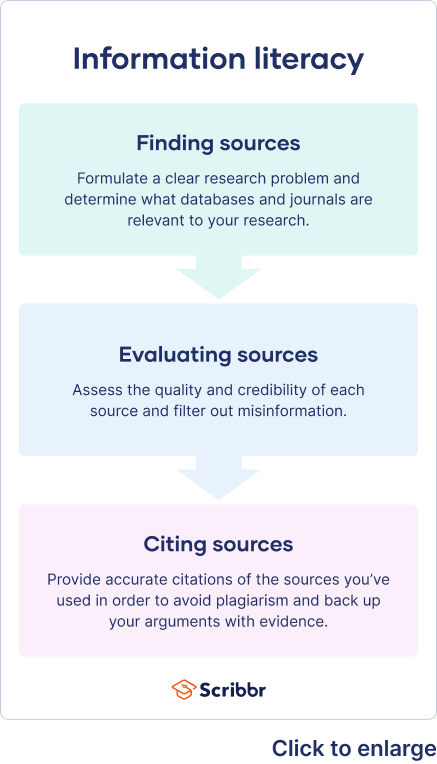Student Guide: Information Literacy | Meaning & Examples
Information literacy refers to the ability to find, evaluate, and use sources effectively. The term covers a broad range of skills, including the ability to:
- Navigate databases
- Find credible sources
- Cite sources correctly
Why is information literacy important?
The vast amount of information available online means that it can be hard to distinguish accurate from inaccurate sources. Published articles are not always credible and sometimes reflect a biased viewpoint intended to sway the reader’s opinion.
Outside of academia, think of the concept of fake news: deliberately spreading misinformation intended to undermine other viewpoints. Or native advertising, designed to match other content on a site so that readers don’t notice they’re reading an advertisement.
It’s important to be aware of such unreliable content, to think critically about where you get your information, and to evaluate sources effectively, both in your research and in your media consumption more generally.
Information literacy skills
Information literacy is really a combination of skills and competencies that guide your research. Each stage of a research project, from choosing a thesis statement to writing your research paper, will require you to use specific skills and knowledge.
Being information literate means that you:
- Know how to find sources
- Can assess the authority and credibility of a source
- Can distinguish biased from unbiased content
- Can use relevant sources to inform your research
- Understand what constitutes plagiarism
- Know how to cite your sources correctly
Finding sources
An early stage in the research process is finding relevant sources. It’s important to understand how to search for these sources efficiently.
First, you need to consider what kind of sources you’re looking for. This will depend on the topic and focus of your project, and what stage you are at in the research process.
In the beginning, you may be looking for definitions or broad overviews of a topic. For this, you might use a tertiary source, like an encyclopedia or a dictionary, that is just for your own understanding. Further along, you might look for primary and secondary sources that you will actually cite in your paper. It’s important to ensure that all sources you consult are reliable.
- Websites: Look for websites with legitimate domain extensions (.edu or .gov).
- Search engines: When using search engines to find relevant academic journals and articles, use a trusted resource, like Google Scholar.
- Databases: Check your institution’s library resources to find out what databases they provide access to. Consider what databases are most appropriate to your research.
Finding the right sources means:
- Having a clear research problem
- Knowing what databases and journals are relevant to your research
- Knowing how to narrow and expand your search
Once you have a well-defined research problem, specific keywords, and have chosen a relevant database, you can use Boolean operators to narrow or expand your search. With them, you can prioritize and exclude keywords and search for exact phrases.
Evaluating sources
Evaluating the quality and credibility of a source is an important way of filtering out misinformation. A reliable source will be unbiased and informed by up-to-date research, and it will cite other credible sources.
You can evaluate the quality of a source using the CRAAP test. “CRAAP” is an acronym that informs the questions you should ask when analyzing a source. It stands for:
- Currency: Is the source recent or outdated?
- Relevance: Is it relevant to your research?
- Authority: Is the journal respected? Is the author an expert in the field?
- Accuracy: Is the information supported by evidence? Does the source provide relevant citations?
- Purpose: Why was the source published? What are the author’s intentions?
How you evaluate a source based on these criteria will depend on the specific subject. In the sciences, conclusions from a source published 20 years ago may have been disproven by recent findings. In a more interpretive subject like English, an article published decades ago might still be relevant.
Citing sources
Just as you look for sources that are supported by evidence and provide correct citations, your own work should provide relevant and accurate citations when you quote or paraphrase a source.
Citing your sources is important because it:
- Allows you to avoid plagiarism
- Establishes the credentials of your sources
- Backs up your arguments with evidence
- Allows your reader to verify the legitimacy of your conclusions
The most common citation styles are:
- APA Style: Typically used in the behavioral and social sciences
- MLA style: Used in the humanities and liberal arts
- Chicago style: Commonly used in the sciences and for history
It’s important to know what citation style your institute recommends. The information you need to include in a citation depends on the type of source you are citing and the specific citation style you’re using. An APA example is shown below.
You can quickly cite sources using Scribbr’s free Citation Generator.
Other interesting articles
If you want to know more about ChatGPT, AI tools, citation, and plagiarism, make sure to check out some of our other articles with explanations and examples.
ChatGPT
Frequently asked questions about information literacy
- What is information (digital) literacy?
-
Information literacy refers to a broad range of skills, including the ability to find, evaluate, and use sources of information effectively.
Being information literate means that you:
- Know how to find credible sources
- Use relevant sources to inform your research
- Understand what constitutes plagiarism
- Know how to cite your sources correctly
- Why is information literacy important?
-
It can sometimes be hard to distinguish accurate from inaccurate sources, especially online. Published articles are not always credible and can reflect a biased viewpoint without providing evidence to support their conclusions.
Information literacy is important because it helps you to be aware of such unreliable content and to evaluate sources effectively, both in an academic context and more generally.
- What makes a source credible?
-
A credible source should pass the CRAAP test and follow these guidelines:
- The information should be up to date and current.
- The author and publication should be a trusted authority on the subject you are researching.
- The sources the author cited should be easy to find, clear, and unbiased.
- For a web source, the URL and layout should signify that it is trustworthy.
- What is the CRAAP test?
-
The CRAAP test is an acronym to help you evaluate the credibility of a source you are considering using. It is an important component of information literacy.
The CRAAP test has five main components:
- Currency: Is the source up to date?
- Relevance: Is the source relevant to your research?
- Authority: Where is the source published? Who is the author? Are they considered reputable and trustworthy in their field?
- Accuracy: Is the source supported by evidence? Are the claims cited correctly?
- Purpose: What was the motive behind publishing this source?
- When do I need to cite sources?
-
At college level, you must properly cite your sources in all essays, research papers, and other academic texts (except exams and in-class exercises).
Add a citation whenever you quote, paraphrase, or summarize information or ideas from a source. You should also give full source details in a bibliography or reference list at the end of your text.
The exact format of your citations depends on which citation style you are instructed to use. The most common styles are APA, MLA, and Chicago.
Cite this Scribbr article
If you want to cite this source, you can copy and paste the citation or click the “Cite this Scribbr article” button to automatically add the citation to our free Citation Generator.
Ryan, E. (2023, May 31). Student Guide: Information Literacy | Meaning & Examples. Scribbr. Retrieved November 3, 2023, from https://www.scribbr.com/working-with-sources/information-literacy/

